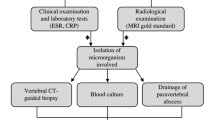Abstract
We evaluated the role of MRI in the diagnosis of postoperative spondylodiscitis. Spondylodiscitis is a serious complication of surgery, and the diagnosis frequently depends on a combination of clinical, laboratory and imaging findings. We compared the MRI findings in six patients with biopsy- or surgery-proven spondylodiscitis with those in 38 asymptomatic postoperative patients. Contrast enhancement and signal changes in the intervertebral disc or the vertebral endplates are not specific for spondylodiscitis, being also seen in the asymptomatic patients. However, absence of Modic type 1 changes, of contrast enhancement of the disc or of enhancing paravertebral soft tissues suggests that the patient does not have spondylodiscitis. MRI appears more useful for exclusion than for confirmation of postoperative spondylodiscitis.
Similar content being viewed by others
Author information
Authors and Affiliations
Additional information
Received: 3 September 1999 Accepted: 25 November 1999
Rights and permissions
About this article
Cite this article
Van Goethem, J., Parizel, P., van den Hauwe, L. et al. The value of MRI in the diagnosis of postoperative spondylodiscitis. Neuroradiology 42, 580–585 (2000). https://doi.org/10.1007/s002340000361
Issue Date:
DOI: https://doi.org/10.1007/s002340000361




